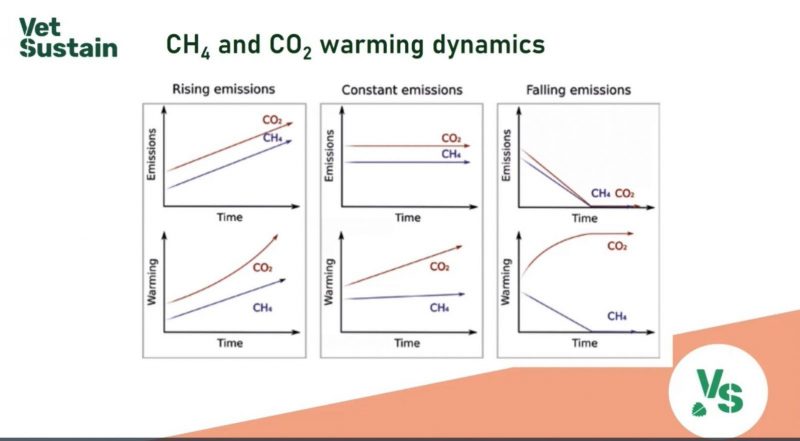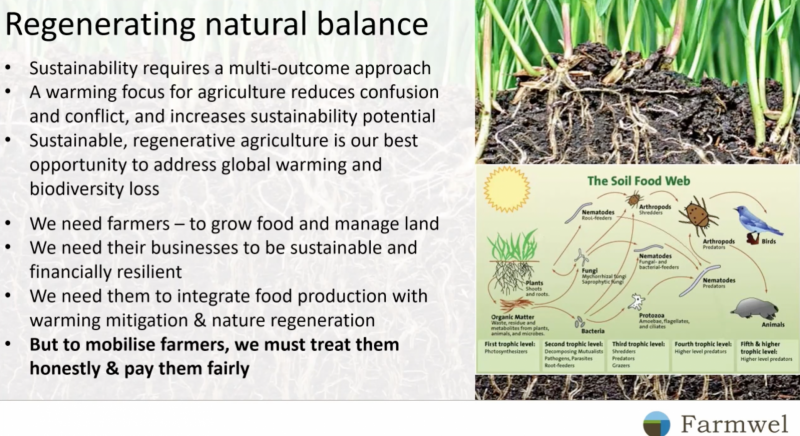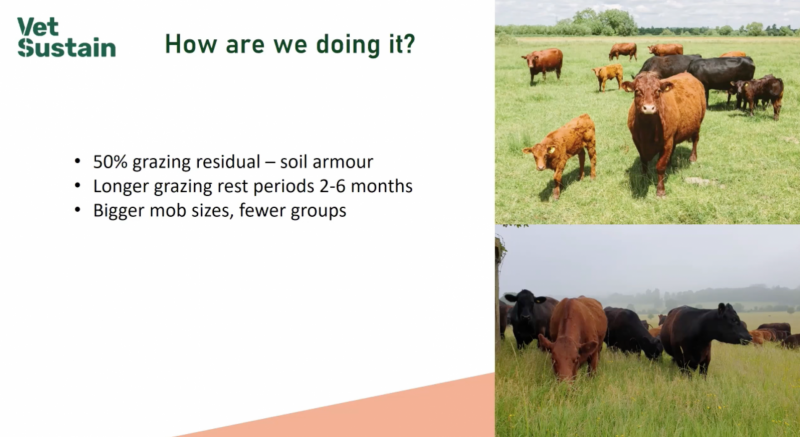Climate change, ruminant methane and GWP*
A recent webinar hosted by Vet Sustain, The Webinar Vet and FAI Farms highlighted the options for measuring climate pollutants from farming, informing debates around the contribution to global heating and considering policy solutions for a climate changing world. In this article, Alice Geddes provides a synopsis of the webinar and its take-home messages.
Alice Geddes
John Lynch, University of Oxford
Our first speaker was John Lynch, an environmental scientist and post-doctoral researcher in the Department of Physics at the University of Oxford.
Greenhouse gas (GHG) emissions occur as a result of ruminant production from a number of sources. Firstly, carbon dioxide (CO₂) is emitted, for example, as a result of on-farm energy use like powering machinery. Methane is generated from the animals themselves, as a by-product of rumen fermentation with some methane also emitted from manure. Nitrous oxide is also emitted from manure but also from fertiliser application. Although the on-farm stage accounts for the greatest proportion of the footprint, also to be considered are the pre-farm emissions or embedded emissions including those arising from land use change, bought-in feed inputs and fertiliser manufacture.
Of all the greenhouse gases, 35-40% of all human-derived methane emissions and 80% of agricultural methane comes from livestock (Steinfeld et al., 2006). Our understanding of methane is fundamental to our understanding of sustainable food animal production.
Currently, when expressing the warming impacts of different gases, we report this as a CO₂ equivalent (CO₂e), which typically uses the 100-year global warming potential (GWP100) metric. However, this method is known to simplify some of the dynamics resulting from the differences in lifespan of the gases in the atmosphere, especially for shorter-lived gases like methane. This is important for ruminant agriculture, as methane is reported as the primary contributor to GWP100-based ‘carbon footprints’.
Methane is a potent GHG with a very strong initial warming impact; however it only has a short atmospheric lifespan, naturally breaking down within a couple of decades. This differs significantly from carbon dioxide, with its potential warming impact for thousands of years. Nitrous oxide has an intermediate impact between the other two gases.

Figure 1: The warming dynamics of carbon dioxide (CO₂) and methane (CH₄).
Rising emissions of both carbon dioxide and methane result in increasing global warming. Constant emissions of carbon dioxide lead to the accumulation of the gas in the atmosphere and an increase in warming. In contrast, constant emissions of methane do not increase the levels of methane in the atmosphere; in fact they stabilise over time as the emissions replace those that are degrading. If we reduce emissions of carbon dioxide to zero, warming will stabilise; if we reduce methane emissions, we reverse some of the warming that has already happened and we currently experience.
To take into account these differences, the team at Oxford have proposed an alternative metric - GWP*. The principle being that methane and carbon dioxide are not directly comparable, with GWP* improving our understanding of the true warming potential of the different gases.
If we can reduce emissions of methane by small amounts each year, there will be no additional warming from methane, which is equivalent to ceasing carbon dioxide emissions. The GWP* metric captures the reversibility of warming, that GWP100 does not.
Despite all of this, there are some things that GWP* doesn’t change: we already know that we need to reduce GHG emissions. Methane is a potent GHG and stabilising its levels in the atmosphere is not enough. What GWP* reveals, is the nuance that can be missed with the existing metrics. It can inform a pathway to ‘net-zero’, and our discussions over the fair share of mitigation efforts.
ffinlo Costain, Farmwel
Our second speaker was ffinlo Costain, chief executive of Farmwel and producer of the Farm Gate podcast.
Global warming is a clear and present danger, methane levels are increasing and these have a powerful warming effect. However, there is no doubt that the role of stable ongoing ruminant methane has been overstated. In fact, a 0.3% reduction in ruminant methane year-on-year delivers net zero warming from methane alone.
‘Net zero’ was traditionally thought about in terms of emissions, but we should really place emphasis on the warming that is associated with those emissions. If we focus on net zero warming, our priorities shift, encouraging us to think more broadly about how we can achieve that, using a multi-outcome approach to land use.
Global heating is just one of the crises we face: loss of biodiversity and soil degradation are occurring in tandem and equally threaten human existence. In order to tackle these issues together, we need to focus on the outcomes of high quality nutrient-dense food production, mitigation of global warming, and biodiversity regeneration - we also need supply chain innovation to ensure that people can access sustainable food and reward farmers working to higher standards.
GWP* is by no means a licence to increase ruminant production. However, it helps us to understand that some systems of ruminant production can be compatible with ‘net zero’. Sustainable, regenerative agriculture can help to address a number of environmental issues such as global warming and biodiversity loss.
As a result of the science from the team at Oxford, demands on agriculture need to change, and net zero warming should be the goal that farmers work towards. The IPCC and the Committee on Climate Change (CCC) now accept GWP* as a more accurate metric, a sign of encouraging progress.
As a first step, farmers should use a carbon footprinting tool (such as Agrecalc) to analyse the impact of their business. GWP* will soon be available within footprinting tools, so that farmers can understand not only their emissions, but more importantly their warming impact. On-farm decisions about future land use should be taken using GWP*, and action to mitigate a farmer’s business impact should be integrated within that same farm system wherever possible. In this way it will be possible for farmers to deliver the multiple outcomes of high quality food production, warming mitigation and biodiversity regeneration.

Figure 2: Regenerating the natural balance through regenerative agriculture
Claire Hill, Agricultural Strategy director at FAI Farms
Our last speaker was Claire Hill from FAI.
FAI farms is a 1200 acre estate, located just outside Oxford, farming beef, sheep and laying hens. Two years ago they achieved a grain-free status in the ruminants with all livestock finished on grass or fodder grown on-farm. It was converted to an organic system in 2000, although an increasing focus on the health of the soil led the team to start farming regeneratively in the last 12 months.
Applying GWP* to GHG emissions at FAI results in a reduction in their footprint of 76%. Rather than a ‘get out of jail free’ card, it allows them to focus on reducing the emissions of long atmospheric lifespan gases - carbon dioxide and nitrous oxide.
At FAI, carbon dioxide emissions were already low due to their organic system, with low feed inputs and no use of chemical pesticides or nitrogen fertilisers. However, a transition to 100% pasture fed has meant removing the emissions associated with bought-in feed (land use change, fertilisers, fuel for processing and transport). What’s more, adopting regenerative agriculture is delivering many other gains for the environment, by ‘building a house’ for soil biology and increasing organic matter.
There is no prescription on how to farm in a regenerative manner. However most definitions focus around a number of key things:
- Soil regeneration
- Water cycling
- Mineral cycling
- Nutrient cycles
- Climate resilience
- Farmer resilience
- Profitability
- Producing food
Regenerative agriculture involves a mindset shift for everyone on the farm. It starts by understanding successional state, looking at what grows and understanding what nature is trying to do. Thistles, for example, are low on the successional ladder of regeneration, and are nature's way of covering bare soil, coincidentally having deep tap roots to break through compaction.
Fields are rested between 2-6 months and around 50% of the grass is left behind. This remaining grass is not wasted, but breaks down to create and re-build the soil. To allow these longer rests, animals are kept in large, high impact groups using electric fences, moving every 24/36 hours around the farm. Each field must be treated differently, understanding where on the successional state it sits and understanding what needs to be achieved.

Figure 3: Changes being made at FAI farms
For the soil to be considered healthy we are advised to have 13 species of plants growing, with the interactions of these in the soil web unlocking minerals and allowing plants to become more deeply rooted. There is often criticism of large arable monocultures, however much of our grassland is also a monoculture, either rye grass alone or mixed with clover. Rye grass is not a plant native to the UK and our soil biology is not designed to host it.
Summary
This was another brilliant webinar from Vet Sustain, connecting the science, context and practical application of GWP*. Accurately reporting GHG emissions from ruminant methane in terms of warming impact has to be the first key step in understanding where the industry needs to move over the coming years. From there we need to see a more holistic approach to climate change mitigation, ecosystem restoration and wholesome food production.
To keep an eye out for more events from Vet Sustain - follow their Facebook page and to get involved in the discussion join the Veterinary Sustainability Forum. Finally, don’t forget to sign up for their newsletter to keep up to date with all the great work being done.
Acknowledgements
Thank you to our three speakers for their time and contributions to this event.
References
Steinfeld, H. et al. (2006) Livestock’s Long Shadow. FAO, Rome. p 112.